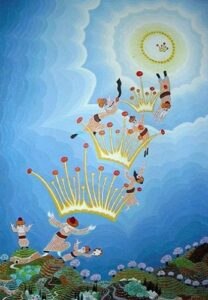בס”ד
By Rabbi Moshe Goodman, Kollel Ohr Shlomo, Hebron

Hebron is the cradle of the Davidic dynasty of which the Mashiach is a continuation. This kingship
reminds of the kingship of Hashem, a primary theme of Rosh Hashana. This painting exhibits primary
Rosh Hashana themes such as the kingship of Hashem, symbolized by the crowns seen here, the theme of
remembrance, symbolized by the crown’s recurrence in different realms or “ages/times,” and of course
seen here is also the theme of the shofar. In addition, we see that each crown has nine red “beads” at its
points, except for the top crown, a matter that may hint to the theme of the number nine on Rosh Hashana,
as seen in the nine blessings of the Musaf Rosh Hashana prayer, the nine calls of the shofar called for on a
Biblical level, and the nine verses of Torah, Nevi’im, and Ketuvim [three for each] without the closing
verse from the Torah. In regard to numbers of blessings in the Amida there also may be a hint to the
Amida of the weekday which has 19 blessings by the 19 purple trees seen here, and the Shabbat/Yom tov
Amida, which has seven blessings may also be hinted by the seven blue bushes at the left. The top crown
has six red beads, perhaps hinting to a Kabbalistic concept in which one of the spiritual entities [coined
Z”A] has six sefirot initially but then “grows” to nine sefirot. There are four crowns which seem to hint to
the four worlds: Atzilut, Briah, Yetzira, and Asiah.
We see seven hasidim, the special Jewish number found in so many of R’ Nachshon’s paintings. Three
hasidim are seen together in the heavens, perhaps hinting to the sefirot hesed, gevura, and tiferet
considered more “heavenly” sefirot. The hasid descending with head downards seems to hint to hesed
which is considered to “give” and “descend” from above to below. The hasid sounding the shofar, a ram’s
horn, hints to gevura associated with Yitzhak in whose stead a ram was offered in the Akeida. In between
these two hasidim is the hasid corresponding to tiferet, considered to be in between hesed and gevura, and
also has a “connecting” feature, and indeed this hasid “connects” two crowns. There are three hasidim
seen on the earth, and this seems to hint to the three more “earthly” sefirot of netzach, hod, and yesod.
The hasid playing a taberinth seems to hint to netzach, a term also used in musical context as in
“lamenatzeach” [see Tehilim] – to the musical conductor. The hasid standing over a wall seems to hint to
the sefira hod, since a wall is a symbol of bordering and limitation associated with the sefira of hod [there
is more to explain on this but this would pass the scope of this piece]. The large hasid with very
outstretched arms, as if “uplifting” the world, corresponds to yesod, which means foundation, as in the
verse “a tzadik is the foundation [“uplifting”] the world.” The hasid with a black beard stands out since all the other hasidim have white beards. The black beard seems to hint to his young age, and the sefira of
malchut is considered to be the smallest/”youngest” of all the sefirot [also black hue is associated with
malchut].



